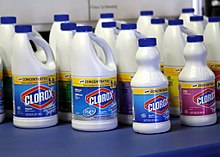
Back مركبات ذات أساس كلوري Arabic ترکیبات آزادکننده کلر Persian କ୍ଲୋରିନ ବେସ କମ୍ପାଉଣ୍ଡ OR Compostos à base de cloro Portuguese Hợp chất gốc clo Vietnamese
 One brand of chlorine based bleach | |
| Clinical data | |
|---|---|
| Other names | Chlorine-releasing disinfectants,[1] chlorine base compounds, chlorine-releasing bleach, chlorine based bleach |
| Drug class | Disinfectant |
| ATC code | |
Chlorine-releasing compounds, also known as chlorine base compounds, is jargon to describe certain chlorine-containing substances that are used as disinfectants and bleaches. They include the following chemicals: sodium hypochlorite (active agent in bleach), chloramine, halazone, and sodium dichloroisocyanurate.[2] They are widely used to disinfect water and medical equipment, and surface areas as well as bleaching materials such as cloth. The presence of organic matter can make them less effective as disinfectants.[3] They come as a liquid solution, or as a powder that is mixed with water before use.[2]
Side effects if contact occurs may include skin irritation and chemical burns to the eye.[2] They may also cause corrosion and therefore may require being rinsed off.[3] Specific compounds in this family include sodium hypochlorite, monochloramine, halazone, chlorine dioxide, and sodium dichloroisocyanurate.[2][4] They are effective against a wide variety of microorganisms including bacterial spores.[4][3]
Chlorine-releasing compounds first came into use as bleaching agents around 1785,[5] and as disinfectants in 1915.[6] They are on the World Health Organization's List of Essential Medicines.[7] They are used extensively in both the medical and the food industry.[4]
- ^ Cheesbrough M (2005). District Laboratory Practice in Tropical Countries. Cambridge University Press. p. 68. ISBN 9781139445290.
- ^ a b c d World Health Organization (2009). Stuart MC, Kouimtzi M, Hill SR (eds.). WHO Model Formulary 2008. World Health Organization. pp. 323–324. hdl:10665/44053. ISBN 9789241547659.
- ^ a b c Hayes R (2013). Food Microbiology and Hygiene (2nd ed.). Springer Science & Business Media. p. 361. ISBN 9781461535461.
- ^ a b c Block SS (2001). Disinfection, Sterilization, and Preservation. Lippincott Williams & Wilkins. p. 1082. ISBN 9780683307405.
- ^ Bartels V (2011). Handbook of Medical Textiles. Elsevier. p. 370. ISBN 9780857093691.
- ^ Sondossi M (2000). "Biocides". In Alexander M, Bloom BR, Hopwood DA, Hull R, Iglewski B, Laskin AI, Oliver SG, Schaechter M, Summers WC (eds.). Encyclopedia of Microbiology, Four-Volume Set (2 ed.). Academic Press. p. 447. ISBN 9780080548487.
- ^ World Health Organization (2019). World Health Organization model list of essential medicines: 21st list 2019. Geneva: World Health Organization. hdl:10665/325771. WHO/MVP/EMP/IAU/2019.06. License: CC BY-NC-SA 3.0 IGO.